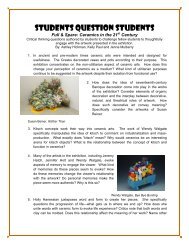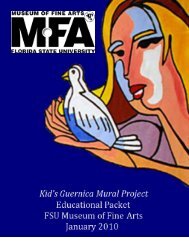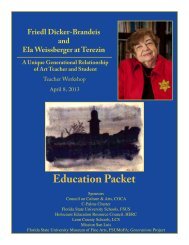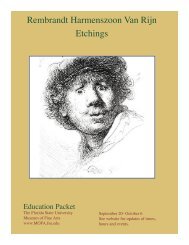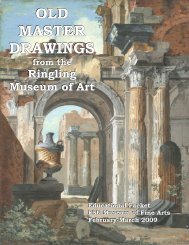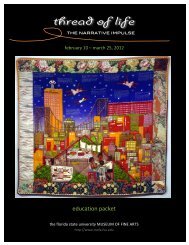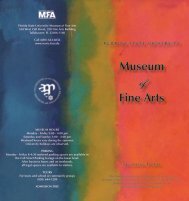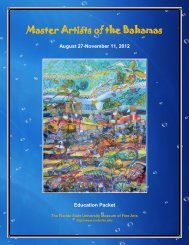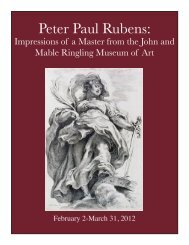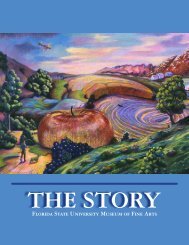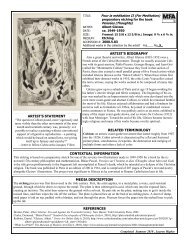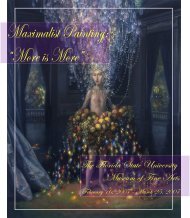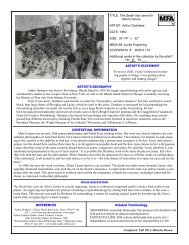Matrix: Contemporary Printmaking - Museum of Fine Arts - Florida ...
Matrix: Contemporary Printmaking - Museum of Fine Arts - Florida ...
Matrix: Contemporary Printmaking - Museum of Fine Arts - Florida ...
You also want an ePaper? Increase the reach of your titles
YUMPU automatically turns print PDFs into web optimized ePapers that Google loves.
Fall 2009<br />
How Technology has changed <strong>Printmaking</strong><br />
When we consider the vastly<br />
different uses <strong>of</strong> prints throughout history, it<br />
is difficult to see where prints might fit into<br />
our modern society. In the years before<br />
computers and the internet, prints were<br />
made as a way <strong>of</strong> advertising an artist’s<br />
skills, or a way to send back images from a<br />
new land. During the time <strong>of</strong> newspapers,<br />
the printing press led the mass production<br />
<strong>of</strong> images and text allowing more <strong>of</strong> the<br />
public to gain access to the news and<br />
current events in their societies.<br />
With the internet today, there is<br />
literally almost no need for any printed<br />
newspapers. Many companies are<br />
switching to online publications in order to<br />
be more eco-friendly. With laser printers<br />
and Xerox machines, the idea <strong>of</strong><br />
painstakingly creating a lithograph or<br />
etching seems humorous. Today<br />
printmaking is used solely as an art form.<br />
This has allowed modern printmakers to<br />
create exceptionally beautiful and creative<br />
prints, which push the boundaries <strong>of</strong><br />
traditional printmaking.<br />
Many modern printmakers create<br />
their prints by incorporating the new tools<br />
and technologies available, even those<br />
used in everyday household chores. The<br />
artist Willie Cole is a prime example <strong>of</strong> this.<br />
He makes lithographs that are based on the<br />
patterns left by an iron when it is face down<br />
for too long.<br />
Willie Cole<br />
Pressed<br />
Iron<br />
Blossom<br />
2005<br />
By incorporating the iron into his<br />
prints Cole merges a modern technology<br />
with the antique technique <strong>of</strong> printmaking.<br />
Modern printmakers also incorporate<br />
unique subject matter reflecting the new<br />
freedom they feel with prints viewed purely<br />
as art. The artist Mark Hosford (biography<br />
on page 27) composes wildly imaginative<br />
and colorful images. In his prints Hosford<br />
draws fictional creatures with multiple arms<br />
and distorted bodies. His figures seem to<br />
float defying the laws <strong>of</strong> physics. Hosford<br />
said these images came from his overactive<br />
imagination as a child.<br />
Mark Hosford<br />
Weight <strong>of</strong> Worm<br />
2005<br />
With the rapid<br />
advancement <strong>of</strong> the digital contribution to<br />
the art world, many artists have begun to<br />
play with the idea <strong>of</strong> the perfection achieved<br />
by such media. Imi Hwangbo creates prints<br />
by hand to mimic<br />
digital precision. She<br />
creates lithographs<br />
that display an exact<br />
repetition and<br />
patterning. Hwangbo<br />
painstakingly creates<br />
prints in the tradition<br />
<strong>of</strong> the old masters,<br />
as if simply using a<br />
computer is not an<br />
option.<br />
Imi Hwangbo<br />
Echo Keeper 1<br />
2001<br />
20



